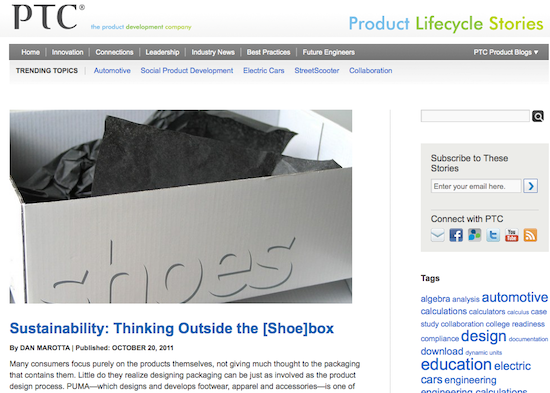 Parametric Technology Corporation, better known as PTC, provides software solutions to over 25,000 business clients who develop products for industries ranging from retail to aerospace and defense. It’s a world filled with talk of CAD and robots, which is also the native language on PlanetPTC, an online user community that led PTC’s foray into content marketing in early 2010.
Parametric Technology Corporation, better known as PTC, provides software solutions to over 25,000 business clients who develop products for industries ranging from retail to aerospace and defense. It’s a world filled with talk of CAD and robots, which is also the native language on PlanetPTC, an online user community that led PTC’s foray into content marketing in early 2010.
At the helm of PTC’s content marketing explorations is Bill Heggie. As the company’s creative director, Heggie has implemented systems for generating and producing content for PlanetPTC, as well as various social networks and blogs, like Product Lifecycle Stories, which aims to expand PTC’s online audience by covering topics such as the state of R&D in the United States (original reporting from a seasoned journalist) and the Justice Department raid on Gibson Guitar.
Heggie recently spoke with us about PTC’s content marketing model, offering plenty of practical ideas to help shape your own.
TCM: Why is content marketing important to PTC?
BH: The nature of relevance is changing. We need to stay ahead of it.
TCM: What is the messaging?
BH: There’s no messaging strategy per se. That would imply that we’re advancing our own messages. This is about the world beyond PTC. There’s a content strategy: write frequently and well, about topics that we believe will be of interest to our readers. We align these with our own interests but do not advance our own messages through this particular channel.
TCM: What was the initial thinking about having a blog? Was it a hard sell for the company?
BH: Initially, the blog was conceived as an outlet for content defined by the principal of brand journalism, as popularized by David Meerman Scott, among others. By reporting stories that are current—often real-time—relevant, interesting, and useful, we extend our audience beyond our traditionally dominant design-engineering community. Given the increasingly powerful, even insightful, nature of the latest search algorithms, the value of our presence is enhanced from an SEO perspective.
The concept was not a hard sell. The idea of good writing enhanced by the best search science appeals to common sense in the first place.
TCM: Why is telling “product lifestyle stories” important to PTC? What is the effect on your customers?
BH: We have an obligation, as part of an incredibly dynamic and innovative industry, to look beyond our own product portfolio and help that industry understand trends, experiences, and best practices from which they can benefit. Because we’re not couching this information as part of any sales process—it’s not about us—we’re able to credibly serve as an editor for our readers and serve them information which, if not directly about their functions, is enlightening or entertaining in a professional context.
TCM: How has PTC’s content strategy changed over the past couple years?
BH: It’s becoming more and more orderly and strategic. Rather than succumb to analysis paralysis around defining and preparing a massive pipeline of content, we focused on developing and launching the site, invoking the basic principles of brand journalism and good writing. We enlisted the entire organization to enhance our core content team and got moving. Once launched, the momentum of the initiative helped carry it forward, as the core team now develops writing talent, monitors trends and topics that are relevant to our audiences, and, critically, plans for publication according to an evolving editorial policy and calendar. As we mature as a publication, search-originated and direct traffic is consistently improving.
TCM: Tell us about your operation: Who is the content team? How does it break down in terms of roles?
BH: Product Lifecycle Stories has a full-time editor, and our web development team within PTC’s internal agency is available to support and enhance the site. We rely on four channels for content, under the leadership of the editor.
First is the internal agency team. Our editor, Nancy Pardo, is an excellent writer, has a strong grasp of our company, competitors, and industry, and is also a prolific creator. Several other agency writers contribute. That full-time attention, accountability, and ownership is critical for a vehicle that requires daily cultivation to remain interesting and relevant.
Second, our entire marketing department, 150 professionals around the world, have been enlisted and have responded enthusiastically, and we’ve found some terrific writers.
Third, we hire external reporters and freelancers—professional journalists, analysts, and writers—to contribute longer, more detailed, fully reported content than a full-time marketer at PTC has the bandwidth to execute.
Fourth, we curate.
TCM: How does the editorial process work at PTC? Do authors receive ideas from the editor? Or are they encouraged to come up with them on their own?
BH: We encourage submissions from throughout the organization generally, and vet and edit them according to the blog’s editorial priorities and schedule. Simultaneously, the editor requisitions articles and stories from subject-matter experts in the company according to what we’re looking for at a given time.
TCM: Do you ever survey customers about their content interests? Is there a particular story you can share about how you may have changed directions in content strategy based on what you’ve learned from customers?
BH: Because we encourage commenting on the articles and videos we publish, this feedback is a direct and ongoing channel to customers’ and other readers’ responses. We learned, for example, that our customers had a strong interest in the post-manufacturing field-service market, where products that are made with our software live long and hopefully healthy lives. The service market is now one we seek to deliver useful content about, whereas at launch it was not a focus.
TCM: How do you integrate Twitter, Facebook, YouTube, and email marketing into the mix? Who manages these social networks?
BH: PTC has a full-time social media strategist, Alan Belniak, who guides the company at large and specifically Product Lifecycle Stories in the best practices for integrating and exploiting the social channel to drive traffic and keep customers and prospects informed.
TCM: It’s been said that photos and video work particularly well on platforms such as Facebook. Is this true for PTC?
BH: Absolutely. We have a full-time in-house studio- and video-production team here because of our conviction that video in particular is a preferred medium for our audiences.
TCM: How do you decide when to tell a written story (blog post) versus an oral story (video/podcast)?
BH: To some extent it’s opportunistic. What is the field team submitting? For stories that are particularly visual, we’ll obviously look for video or pictorial components, even if the basic piece is written. Practically speaking, as well, we’ll work with the best material available to us in the timeline available, whatever it is.
TCM: How does your audience learn about new blog posts? Do they subscribe to the stories by email?
BH: Social media updates are driven by PTC RSS and email notices on an opt-in basis; additionally, readers can email and link to stories leveraging their own social networks.
TCM: What makes your content marketing successful?
BH: It starts with listening. Listen first—to the markets, the industry you serve, and the pulse of interest in your customer and prospect arenas. Write well. Publish frequently. Assign clear responsibility for content or content subsets. If possible, put in place a full-time editor or content strategist, depending on your particular content strategy. And tell a good story.


